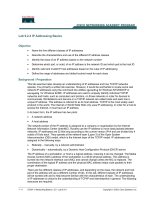Chapter 07 IP addressing services
Bạn đang xem bản rút gọn của tài liệu. Xem và tải ngay bản đầy đủ của tài liệu tại đây (2.15 MB, 88 trang )
Chapter 7: IP Addressing Services
CCNA Exploration 4.0
2
Objectives
3
DHCP
4
Introducing DHCP
•
Every device that connects to a network needs an IP
address.
•
Network administrators assign static IP addresses to routers,
servers, and other network devices whose locations
(physical and logical) are not likely to change.
•
Network devices that are added, moved or changed
(physical and logical) need new addresses. Manual
configuration is unwieldy dynamic configuration.
•
DHCP assigns IP addresses and other important network
configuration information dynamically.
•
DHCP is an extremely useful and timesaving tool for network
administrators.
•
Cisco router can be configured to provide DHCP services,
called Easy IP.
5
DHCP Operation
•
DHCP automatically dynamically assigns, or leases, an IP
address from a pool of addresses for a limited period of time
chosen by the server, or until the client tells the DHCP server
that it no longer needs the address.
•
DHCP works in a client/server mode.
6
BOOTP and DHCP
•
The Bootstrap Protocol (BOOTP), defined in RFC 951, is the
predecessor of DHCP and shares some operational
characteristics.
•
Both DHCP and BOOTP are client/server based and use
UDP ports 67 and 68.
7
DHCP Message Format
8
DHCP Discovery and Offer Methods
9
DHCP Discovery and Offer Methods
10
Configuring a DHCP Server
•
Step 1. Define a range of addresses that DHCP is not to
allocate.
•
Step 2. Create the DHCP pool
11
Configuring a DHCP Server
•
Step 3. Configure the specifics of the pool.
12
Configuring a DHCP Server
•
Example:
•
Disabling DHCP:
–
use the no service dhcp command.
13
Verifying DHCP
14
Verifying DHCP
15
Verifying DHCP
16
Configuring a DHCP Client
17
Configuring a DHCP Client
18
DHCP Relay
•
DHCP Problem
19
DHCP Relay
20
Helper address configuration that relays broadcasts to all servers on the
segment.
RTA(config)#interface e0
RTA(config-if)#ip helper-address 172.24.1.255
But will RTA forward the broadcast?
Broadcast Broadcast
DHCP Relay
21
Directed Broadcast
•
Notice that the RTA interface e3, which connects to the server farm, is not
configured with helper addresses.
•
However, the output shows that for this interface, directed broadcast
forwarding is disabled.
•
This means that the router will not convert the logical broadcast 172.24.1.255
into a physical broadcast with a Layer 2 address of FF-FF-FF-FF-FF-FF.
•
To allow all the nodes in the server farm to receive the broadcasts at Layer 2,
e3 will need to be configured to forward directed broadcasts with the following
command:
RTA(config)#interface e3
RTA(config-if)#ip directed-broadcast
22
Helper address configuration that relays broadcasts to all servers on the
segment.
RTA(config)#interface e0
RTA(config-if)#ip helper-address 172.24.1.255
RTA(config)#interface e3
RTA(config-if)#ip directed-broadcast
L3 Broadcast L2 Broadcast
DHCP Relay
23
•
By default, the ip helper-address command forwards the
following eight UDP services:
–
Port 37: Time
–
Port 49: TACACS
–
Port 53: DNS
–
Port 67: DHCP/BOOTP client
–
Port 68: DHCP/BOOTP server
–
Port 69: TFTP
–
Port 137: NetBIOS name service
–
Port 138: NetBIOS datagram service
•
To specify additional ports, use the ip forward-protocol
command to specify exactly which types of broadcast
packets to forward.
DHCP Relay
24
Configuring a DHCP Server Using SDM
25
Configuring a DHCP Server Using SDM
•
Add a DHCP
Pool









